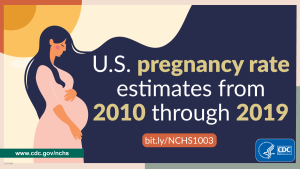U.S. Pregnancy Rates Drop During Last Decade
Posted on by Newly released national pregnancy rate estimates from CDC’s National Center for Health Statistics (NCHS) show declines in the overall and unintended pregnancy rates in the United States for 2010–2019. These are the first pregnancy rate statistics from NCHS since the agency published estimates for 2010 in a report released in 2015. The new report, “Updated Methodology to Estimate Overall and Unintended Pregnancy Rates in the United States,” also provides estimates by age group and for some race and ethnicity groups.
Newly released national pregnancy rate estimates from CDC’s National Center for Health Statistics (NCHS) show declines in the overall and unintended pregnancy rates in the United States for 2010–2019. These are the first pregnancy rate statistics from NCHS since the agency published estimates for 2010 in a report released in 2015. The new report, “Updated Methodology to Estimate Overall and Unintended Pregnancy Rates in the United States,” also provides estimates by age group and for some race and ethnicity groups.
Report Findings
- The total estimated number of pregnancies declined by 9% from 6,069,000 pregnancies in 2010 to 5,507,000 in 2019.
- The overall pregnancy rate (per 1,000 women aged 15–44) was 97.3 in 2010 and 85.6 in 2019, a 12% decline.
- Unintended pregnancy rates declined by 15%, from 42.1 (per 1,000 women aged 15–44) in 2010 to 35.7 in 2019.
- From 2010–2019, the percentage of pregnancies ending in live birth and of those ending in loss each increased 3%, while pregnancies ending in abortion declined 17%.
- Overall pregnancy rates and unintended pregancy rates for teens ages 15-19 declined by more than half (52%) from 2010–
- Unintended pregnancy rates declined from 2010 to 2019 by
- 23% among Hispanic women,
- 17% among non-Hispanic women of races other than Black or White,
- 12% among Black, non-Hispanic women, and
- 11% among White, non-Hispanic women.
Updated methodology
Pregnancy rates are calculated from three components: live births, pregnancy losses (miscarriage or spontaneous abortion, ectopic pregnancy, and stillbirth), and induced abortions. Some of the data sources NCHS previously used to estimate these components had limitations such as the timeliness and completeness of their data.
The new NCHS methodology integrates data from multiple data systems, including pregnancy loss data from the National Survey of Family Growth and birth and fetal death data from the National Vital Statistics System. These methods also use data from CDC’s Abortion Surveillance System, which publishes new data annually. In addition, the new methodology imputes missing abortion data to account for some of the limitations of CDC’s Abortion Surveillance System. Imputing is a statistical technique used to fill gaps in available data. These changes in methodology allow NCHS to provide more timely estimates of pregnancy rates and unintended pregnancies.
The report will be available on the NCHS web site at https://www.cdc.gov/nchs/data/series/sr_02/sr02-201.pdf.
Posted on by

